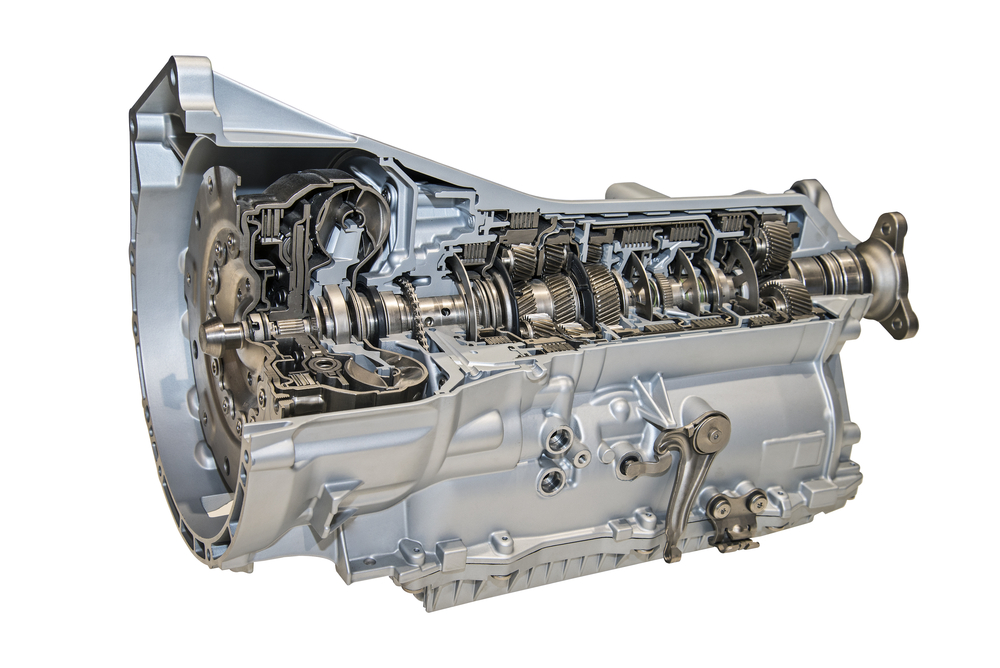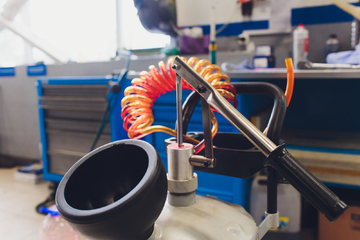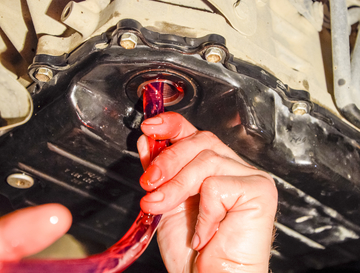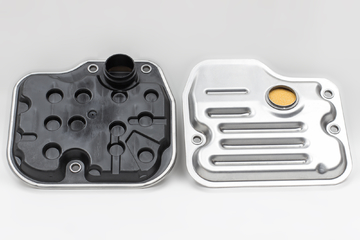
Most people know to change their engine oil every once in a while. Many drivers ignore their transmission fluid until there is a serious problem, which is usually when it needs replacing and a $3,000+ repair. The leading cause of automatic transmission failure is dirty, neglected transmission fluid. Replacing the fluid in an automatic transmission is not difficult. A home mechanic should have a high-quality service and repair manual available for the car before starting the job.
How to Tell it's Time for a Transmission Service
The most common sign of a transmission needing service is slipping. This can happen at a stoplight when the engine RPM increases, but the car does not move, then bangs into gear. It can also happen when accelerating at freeway speeds. Most often, low transmission fluid is the culprit.
How Often Should the Transmission be Serviced?
Most transmissions should have a fluid and filter change every 35,000 to 60,000 miles. Vehicles that spend most of their lives in stop and go driving, hauling heavy loads or off-road driving should be changed more often. Many manufacturers recommend a fluid change at 100,000 miles. Waiting too long to change automatic transmission fluid can loosen debris that can damage the transmission and require an expensive rebuild or replacement.
Checking the Transmission Fluid
In decades past, automatic transmissions had a dipstick, just like the engine oil, except it was checked hot, typically while the engine was running. Drivers knew it was time to change transmission fluid when the color would become brownish or dark red, rather than the typical bright red.
 A transmission flush uses a pump to force clean fluid through the transmission and removes the old fluid.
A transmission flush uses a pump to force clean fluid through the transmission and removes the old fluid.Today, many of the modern transmissions are "sealed-for-life" transmissions with no dipstick. This can make changing fluid much more difficult, but it is not impossible. The life of the transmission can needlessly be cut short by failing to change the transmission fluid. The home mechanic will find it difficult to check fluid levels in these transmissions. A workshop manual can be helpful to the DIYer changing transmission fluid themselves. If you decide to do your transmission fluid change yourself, don't forget to plan how you'll dispose of the fluid beforehand.
Fluid Change vs Fluid Flush
Repair shops offer a service called a transmission flush. Some people swear by them, while others will tell horror stories. The real advantage of a transmission flush is that the shop can hook the transmission up to a remote pump that forces all of the fluid out of the transmission, then refills it with clean fluid. A typical service at a professional transmission shop takes an hour to a few hours to complete.
 Using a transmission flush pump gets almost all of the old fluid out of the automatic transmission.
Using a transmission flush pump gets almost all of the old fluid out of the automatic transmission.Most often, when a transmission flush leads to a major transmission rebuild, it is not because of the flush, but rather pre-existing damage within the transmission that increased due to less restrictive fluid or dislodged debris.
How Much Does a Flush Cost?
The cost for a flush will depend on the service in the area and typically averages $250, not including the filter and pan gasket. It is best to use a shop with a good reputation and avoid shops that advertise a "quick change."
 Always change the transmission filter and the pan or gasket when changing or flushing a transmission.
Always change the transmission filter and the pan or gasket when changing or flushing a transmission.The cost is significantly higher than changing the fluid at home because the flush uses as much as 22 quarts of oil. Typically, the home mechanic will use seven to eight quarts.
How Much Does a Fluid Change Cost?
The reason for this is simple. When draining at home, only gravity works to draw the fluid out, leaving as much as half still in the transmission. The pump used by shops draws almost all of the old fluid out. Transmission fluid can cost $5.00 per quart or more. Many transmissions will also require a friction modifier during a flush or change, and those can cost $20 or more.
 Check with a service or repair workshop manual to determine the type of automatic transmission fluid for the vehicle.
Check with a service or repair workshop manual to determine the type of automatic transmission fluid for the vehicle.Because only some of the fluid is drained out at a time, it is recommended to do several fluid changes over a few days of driving. Some home mechanics will drain and fill, then go for a moderate drive, drain and fill again. A majority of the old fluid will have been removed after three or four changes.
Don't forget to change the filter and pan gasket when flushing or changing the automatic transmission fluid.
Tips and Tricks
Many transmission mechanics refer to "sealed-for-life" transmissions as sealed to death transmissions because there is no dipstick to check the fluid level and condition. This often leads to drivers overlooking the transmission service until a major failure happens. A transmission rebuild can cost $3,500 or more, and it can take a professional transmission shop days or weeks to finish the job.
Automatic transmissions tend to show the first sign of a problem by shifting hard or banging into gear. This condition can be related to low fluid, but also may involve a teardown and rebuild.
Transmissions often fail under hard conditions, like when driving in snow or on a steep hill, exactly the conditions a driver needs to count on the transmission. Regularly checking the fluid and replacing dirty fluid will save thousands in repair bills and keep the car running smoothly for many years.
An automotive workshop repair manual will describe the fill and drain plug location on the transmission. Removing the fill plug according to the workshop manual instructions will let the home mechanic know how much fluid is in a sealed for life transmission.
Automatic transmissions seem frightening to disassemble, inspect, and rebuild. Even the average home mechanic can successfully rebuild an automatic transmission using high-quality parts and a complete workshop manual.
